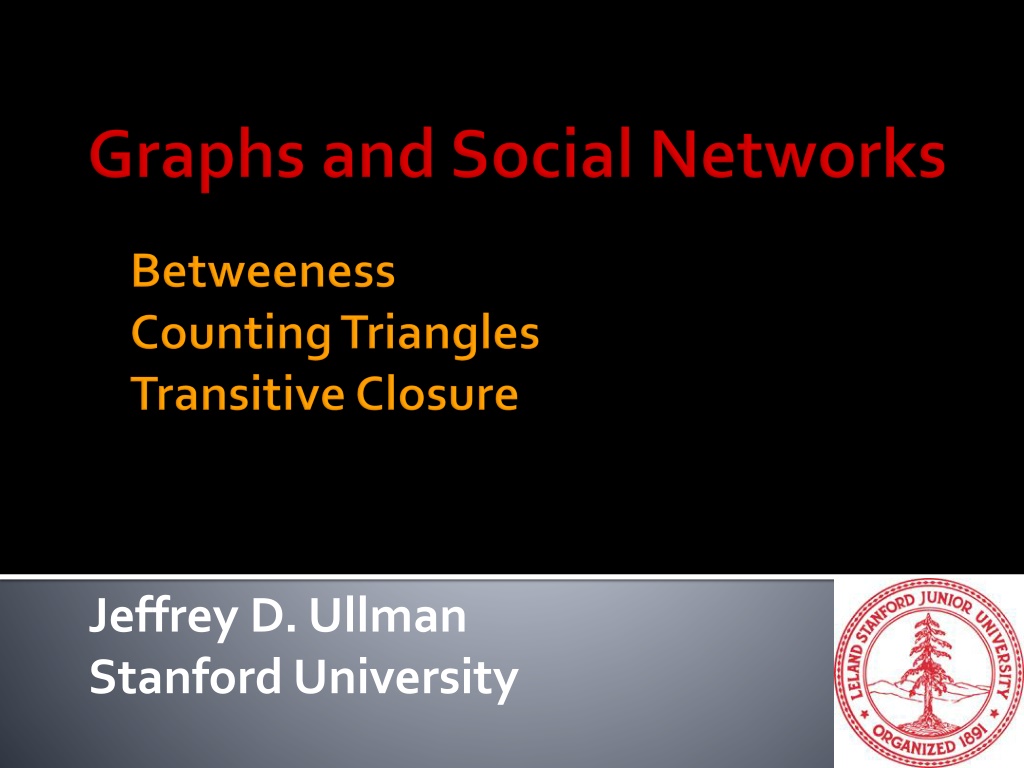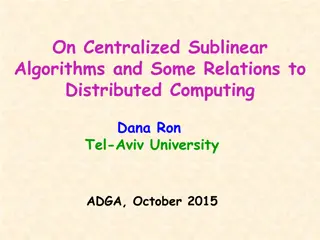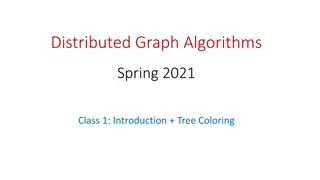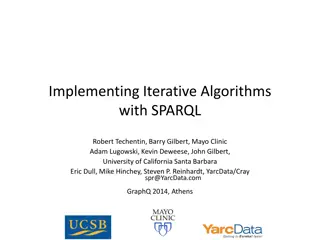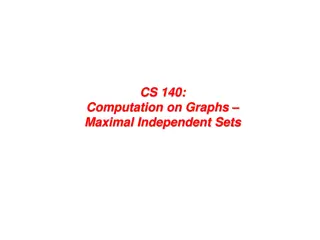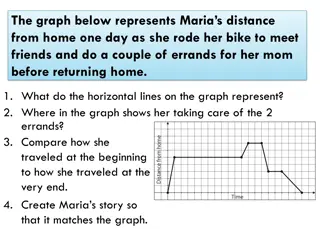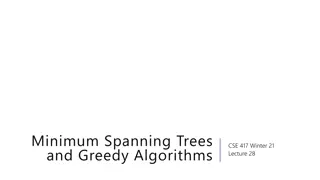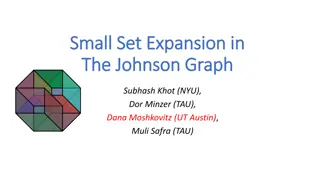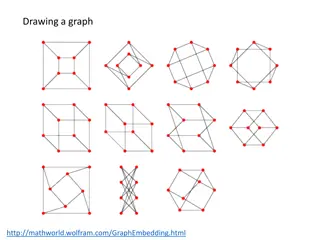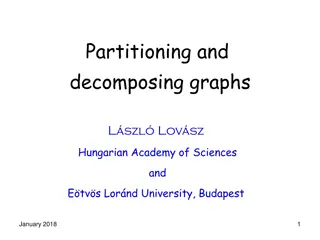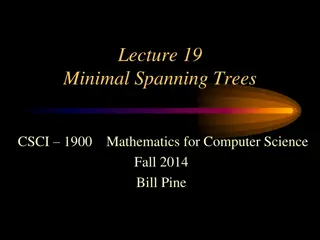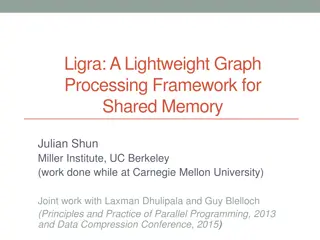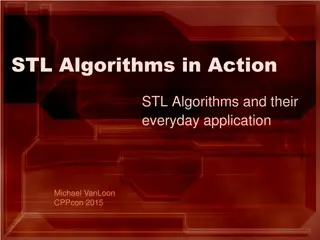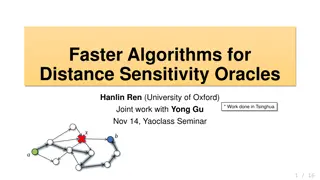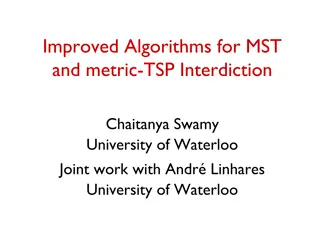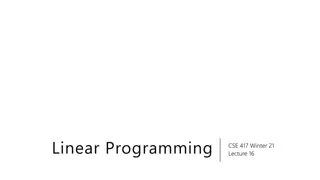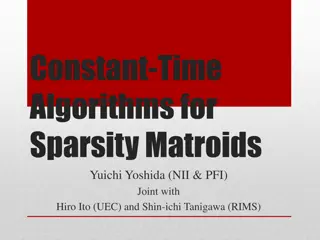Graph Analysis Techniques and Algorithms
Graph analysis involves utilizing different algorithms for parallelizing activities and performing operations like relational joins efficiently in large graphs with small diameters. Techniques such as dividing graphs into communities based on edge betweenness are explored. Breadth-first search is applied to calculate shortest paths and betweenness of edges in a graph.
Download Presentation

Please find below an Image/Link to download the presentation.
The content on the website is provided AS IS for your information and personal use only. It may not be sold, licensed, or shared on other websites without obtaining consent from the author. Download presentation by click this link. If you encounter any issues during the download, it is possible that the publisher has removed the file from their server.
E N D
Presentation Transcript
Jeffrey D. Ullman Stanford University
Different algorithms for the same problem can be parallelized to different degrees. The same activity can (sometimes) be performed for each node in parallel. A relational join or similar step can be performed in one round of MapReduce. Parameters: N = # nodes, M = # edges, D = diameter = maximum over all pairs of nodes of the minimum path length from one node to the other. 2
Many very large graphs have small diameter. Called the small world property. Example: 6 degrees of Kevin Bacon. Example: Erdos numbers. Example: Most pairs of Web pages are within 12 links of one another. But study at Google found pairs of pages whose shortest path has a length in the thousands. 3
Used to divide a graph into reasonable communities. Roughly: the betweenness of an edge e is the number of pairs of nodes (A,B) for which the edge e lies on the shortest path between A and B. More precisely: if there are several shortest paths between A and B, then e is credited with the fraction of those paths on which it appears. Edges of high betweenness separate communities. 5
A B D E C G F Edge (B,D) has betweenness = 12, since it is on the shortest path from each of {A,B,C} to each of {D,E,F,G}. Edge (G,F) has betweenness = 1, since it is on no shortest path other than that for its endpoints. 6
1. Perform a breadth-first search from each node of the graph. 2. Label nodes top-down (root to leaves) to count the shortest paths from the root to that node. 3. Label both nodes and edges bottom-up with the fraction of shortest paths from the root to nodes at or below passing through this node or edge. 4. The betweenness of an edge is half the sum of the labels of that edge, starting with each node as root. Half to avoid double-counting each edge. 7
BFS starting at E 1 Label of root = 1 A B D E E 1 1 C G F F D 1 Label of other nodes = sum of labels of parents 2 G B 1 1 A C 8
1 A B D E E 4.5 1.5 1 1 1.5 C G F 4.5 3 F D Interior nodes get 1 plus the sum of the edges below 0.5 0.5 1 2 3 G B 1 Split of G s label is according to the path counts (black labels) of its parents D and F. 1 1 Edges get their share of their children 1 1 A C 1 1 Leaves get label 1 9
1 A B D E E 4.5 1.5 1 1 1.5 C G F 4.5 3 F D 0.5 0.5 1 2 3 Edge (E,D) has label 4.5. G B 1 This edge is on all shortest paths from E to A, B, C, and D. 1 1 1 1 It is also on half the shortest paths from E to G. A C 1 1 But on none of the shortest paths from E to F. 10
12 5 4.5 A B D E 4 1.5 4.5 1 5 C G F 1.5 11
5 4.5 A B D E 4 1.5 4.5 1 5 C G F 1.5 A sensible partition into communities 12
4.5 A B D E 4 1.5 4.5 1 C G F 1.5 Why are A and C closer than B? B is a traitor to the community, being connected to D outside the group. 13
1. Algorithm can be done with each node as root, in parallel. 2. Depth of a breadth-first tree is no greater than the diameter of the graph. 3. One MapReduce round per level suffices for each part. 14
Why Care? 1. Density of triangles measures maturity of a community. As communities age, their members tend to connect. 2. The algorithm is actually an example of a recent and powerful theory of optimal join computation. 16
Let the graph have N nodes and M edges. N < M < N2. One approach: Consider all N-choose-3 sets of nodes, and see if there are edges connecting all 3. An O(N3) algorithm. Another approach: consider all edges e and all nodes u and see if both ends of e have edges to u. An O(MN) algorithm. Note: we assume sensible data structures that let us look up an edge in O(1) time and find the edges out of a node in time proportional to the number of those edges. 17
To find a better algorithm, we need to use the concept of a heavy hitter a node with degree at least M. Note: there can be no more than 2 M heavy hitters, or the sum of the degrees of all nodes exceeds 2M. A heavy-hitter triangle is one whose three nodes are all heavy hitters. 18
First, find the heavy hitters. Look at all edges and count the degrees of all nodes. Takes time O(M). And one MapReduce job suffices. Consider all triples of heavy hitters and see if there are edges between each pair of the three. Takes time O(M1.5), since there is a limit of 2 M on the number of heavy hitters. 19
At least one node is not a heavy hitter. Consider each edge e. If both ends are heavy hitters, ignore. Otherwise, let end node u not be a heavy hitter. For each of the at most M nodes v connected to u, see whether v is connected to the other end of e. Takes time O(M1.5). M edges, and at most M work with each. 20
Both parts take O(M1.5) time and together find any triangle in the graph. For any N and M, you can find a graph with N nodes, M edges, and (M1.5) triangles, so no algorithm can do significantly better. Hint: consider a complete graph with sqrt(M) nodes, plus other isolated nodes. Note that M1.5 can never be greater than the running times of the two obvious algorithms with which we began: N3 and MN. 21
Needs a constant number of MapReduce rounds, independent of N or M. 1. Count degrees of each node. 2. Filter edges with two heavy-hitter ends. 3. 1 or 2 rounds to join only the heavy-hitter edges. 4. Join the non-heavy-hitter edges with all edges at a non-heavy end. 5. Then join the result of (4) with all edges to see if a triangle is completed. 22
A directed graph of N nodes and M arcs. Arcs are represented by a relation Arc(u,v) meaning there is an arc from node u to node v. Goal is to compute the transitive closure of Arc, which is the relation Path(u,v), meaning that there is a path of length 1 or more from u to v. Bad news: TC takes time O(NM) in the worst case. Good news: But you can parallelize it heavily. 24
Important in its own right. Finding structure of the Web, e.g., strongly connected central region. Finding connections: was money ever transferred, directly or indirectly, from the West-Side Mob to the Stanford Chess Club? Ancestry: is Jeff Ullman a descendant of Genghis Khan? Every linear recursion (only one recursive call) can be expressed as a transitive closure plus nonrecursive stuff to translate to and from TC. 25
A more subtle example is the matter finding cousins = people who have a common ancestor, the same number of generations away from both. Assume Parent(c, p) relation. Basis: Cousin(x,y) if Parent(x,z) AND Parent(y,z). We call these siblings. Induction: Cousin(x,y) if Parent(x,x ) AND Parent(y,y ) AND Cousin(x ,y ). Doesn t look like TC, but it is a linear recursion. 26
Siblings First cousins Second cousins 27
Create a new graph G whose nodes are pairs of people (x,y). An arc in G from (x ,y ) to (x,y) if Parent(x,x ) and Parent(y,y ). Compute the TC in G. If there is a path from (a,b) to (c,d), then if a and b are cousins, then c and d are also cousins. Use TC to find all nodes of G reachable from nodes (x,y) such that x and y have a common parent. 28
The same idea, with different labels for arcs (not just Parent ), yields a simrank calculation. Two entities are similar if they either: 1. Have arcs with the same label from the same node, or 2. Have arcs with the same label from similar nodes. Implemented by a PageRank-like calculation on the graph whose nodes are pairs of entities. Usually with some taxation, so longer paths from the same node imply less similarity than shorter paths. 29
1. Path := Arc; 2. FOR each node u, Path(v,w) += Path(v,u) AND Path(u,w); /*u is called the pivot */ Running time O(N3) independent of M or D. Can parallelize the pivot step for each u. But the pivot steps must be executed sequentially, so N rounds of MapReduce are needed. 31
A pivot on u is essentially a join of the Path relation with itself, restricted so the join value is always u. Path(v,w) += Path(v,u) AND Path(u,w). But (ick!) every tuple has the same value (u) for the join attribute. Standard MapReduce join will bottleneck, since all Path facts wind up at the same reducer (the one for key u). 32
This problem, where one or more values of the join attribute are heavy hitters is called skew. It limits the amount of parallelism, unless you do something clever. But there is a cost: in MapReduce terms, you communicate each Path fact from its mapper to many reducers. As communication is often the bottleneck, you have to be clever how you parallelize when there is a heavy hitter. 33
The trick: Given Path(v,u) facts and Path(u,w) facts: 1. Divide the values of v into k equal-sized groups. 2. Divide the values of w into k equal-sized groups. Can be the same groups, since v and w range over all nodes. 3. Create a key (reducer) for each pair of groups, one for v and one for w. 4. Send Path(v,u) to the k reducers for key (g,h), where g is the group of v, and h is anything. 5. Send Path(u,w) to the k reducers for key (g,h), where h is the group of w and g is anything. 34
Path(u,w) group 1 Path(u,w) group 2 Path(u,w) group 3 k = 3 Path(v,u) group 1 Path(v,u) group 2 Notice: every Path(u,v) meets every Path(u,w) at exactly one reducer. Path(v,u) group 3 35
Depth-first search from each node. O(NM) running time. Can parallelize by starting at each node in parallel. But depth-first search is not easily parallelizable. Thus, the equivalent of M rounds of MapReduce needed, independent of N and D. 36
Same as depth-first, but search breadth-first from each node. Search from each node can be done in parallel. But each search takes only D rounds, not M, provided you can perform the breadth-first search in parallel from each node you visit. Similar in performance (if implemented carefully) to linear TC, which we will discuss next. 37
Large-scale TC can be expressed as the iterated join of relations. Simplest case is where we 1. Initialize Path(U,V) = Arc(U,V). 2. Join an arc with a path to get a longer path, as: Path(U,V) += PROJECTUV(Arc(U,W) JOIN Path(W,V)) or alternatively Path(U,V) += PROJECTUV(Path(U,W) JOIN Arc(W,V)) Repeat (2) until convergence (requires D iterations). 38
Join-project, as used here is really the composition of relations. Shorthand: we ll use R(A,B) S(B,C) for PROJECTAC(R(A,B) JOIN S(B,C)). MapReduce implementation of composition is the same as for the join, except: 1. You exclude the key b from the tuple (a,b,c) generated in the Reduce phase. 2. You need to follow it by a second MapReduce job that eliminates duplicate (a,c) tuples from the result. 39
Joining Path with Arc repeatedly redoes a lot of work. Once I have combined Arc(a,b) with Path(b,c) in one round, there is no reason to do so in subsequent rounds. I already know Path(a,c). At each round, use only those Path facts that were discovered on the previous round. 40
Path = ; NewPath = Arc; while (NewPath != ) { Path += NewPath; NewPath(U,V)= Arc(U,W) NewPath(W,V)); NewPath -= Path; } 41
3 1 2 Path NewPath 4 Initial: - 12, 13, 23, 24 Path += NewPath 12, 13, 23, 24 12, 13, 23, 24 Arc U V Compute NewPath 12, 13, 23, 24 13, 14 1 2 Subtract Path 12, 13, 23, 24 14 1 3 2 3 Path += NewPath 12, 13, 14, 23, 24 14 2 4 Compute NewPath 12, 13, 14, 23, 24 - Done 42
Each Path fact is used in only one round. In that round, Path(b,c) is paired with each Arc(a,b). There can be N2 Path facts. But the average Path fact is compared with M/N Arc facts. To be precise, Path(b,c) is matched with a number of arcs equal to the in-degree of node b. Thus, the total work, if implemented correctly, is O(MN). 43
Each round of seminaive TC requires two MapReduce jobs. One to join, the other to eliminate duplicates. Number of rounds needed equals the diameter. More parallelizable than classical methods (or equivalent to breadth-first search) when D is small. 44
If you have a graph with large diameter, you do not want to run the Seminaive TC algorithm for that number of rounds. Why? Successive MapReduce jobs are inherently serial. Better approach: recursive doubling = compute Path(U,V) += Path(U,W) Path(W,V) for log2(D) number of rounds. After r rounds, you have all paths of length 2r. 45
The seminaive trick works for nonlinear TC as well as for linear TC. But you must use new Path facts in both the first and second positions. 46
Path = ; NewPath = Arc; while (NewPath != ) { Path += NewPath; NewPath(U,V)= Path(U,W) NewPath(W,V)); NewPath -= Path; } Note: in general, seminaive evaluation requires the new tuples to be available for each use of a relation, so we would need the union with another term NewPath(U,W) o Path(W,V). However, in this case it can be proved that this one term is enough. 47
Each Path fact is in NewPath only once. There can be N2 Path facts. When (a,b) is in NewPath, it can be joined with 2N other Path facts. Those of the form Path(x,a) or Path(b,y). Thus, total computation is O(N3). 48
Good news: You generate the same Path facts as for linear TC, but in fewer rounds, often a lot fewer. Bad news: you generate the same fact in many different ways, compared with linear. Neither method can avoid the fact that if there are many different paths from u to v, you will discover each of those paths, even though one would be enough. But nonlinear discovers the same exact path many times. 49
